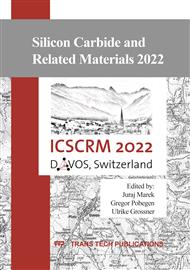p.35
p.43
p.51
p.57
p.63
p.69
p.75
p.85
p.99
Study of Defects in 4H-SiC Epitaxy at Various Buffer Layer Growth Conditions
Abstract:
Buffer layer optimization is a critical technique to mitigate defect propagation from substrate to epilayer, reduce stress, and prevent generation of ingrown defects. In the present study, the impact of dopant transition from substrate to the buffer layer on various epilayer defects was investigated. It was found that a ramped transition of the dopant concentration from substrate to buffer layer is beneficial for reduction of basal plane dislocations in the epilayer compared to an abrupt doping transition. This reduction of defects can be attributed to reduced stress at the substrate-to-buffer layer transition. Tests on buffer layer growth rates also revealed that higher growth rates reduce BPDs (basal plane dislocations) in the epilayers. We believe that BPD conversion in epilayers grown at higher growth rates is energetically more favorable than the conversion at slower growth rates resulting in the observed reduced BPDs at higher growth rates.
Info:
Periodical:
Pages:
63-68
Citation:
Online since:
May 2023
Authors:
Permissions:
Share:
Citation:



